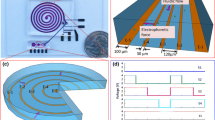Abstract
A lab-on-a-chip for the rapid identification of microbial species has been developed for a water monitoring system. We employed highly parallel DNA microarrays for the direct profiling of microbial populations in a sample. For the integration and minimization of the DNA microarray protocols for bacterial identification, rRNA was selected as a target nucleotide for probe:target hybridization. In order to hybridize target rRNA onto the probe oligonucleotide, intact rRNA extracted fromE. coli rRNA was fragmented via chemical techniques in the lab-on-a-chip platform. The size of fragmented rRNA was less than 400 base pairs, which was confirmed by polyacrylamide gel electrophoresis. The fragmented rRNA was also labeled using fluorescent chemicals. The lab-on-a-chip for fragmentation and labeling includes a PDMS chaotic mixer for efficient mixing, operated by flow pressure. In addition, the fragmented rRNA was hybridized successfully on a DNA microarray with sample recirculation on a microfluidic platform. Our fragmentation and labeling technique will have far-reaching applications, which require rapid but complicated chemical genetic material processing on a lab-on-a-chip platform.
Similar content being viewed by others
References
Boom, R., C. J. A. Sol, M. M. M. Salimans, C. L. Jansen, P. M. E. Wertheim-van Dillen, and J. van der Noordaa (1990) Rapid and simple method for purification of nucleic acids.J. Clin. Microbiol. 28: 495–503.
Oh, M.-K., D. R. Scoles, and S.-M. Pulst, (2005) DNA microarray analysis of immediate response to EGF treatment in rat schwannoma cells.Biotechnol. Bioprocess Eng. 10: 444–450.
Bavykin, S. G., J. P. Akowski, V. M. Zakhariev, V. E. Barsky, A. N. Perov, and A. D. Mirzabekov, (2001) Portable system for microbial sample preparation and oligonucleotide microarray analysis.Appl. Environ. Microbiol. 67: 922–928.
Kelly, J. J., B. K. Chernov, I. Tovstanovsky, A. D. Mirzabekov, and S. G. Bavykin (2002) Radical-generating coordination complexes as tools for rapid and effective fragmentation and fluorescent labeling of nucleic acids for microchip hybridization.Anal. Biochem. 311: 103–118.
Proudnikov, D., E. Timofeev, and A. Mirzabekov (1998) Immobilization of DNA in polyacrylamide gel for the manufacture of DNA and DNA-oligonucleotide microchips.Anal. Biochem. 259: 34–41.
Fantroussi, S. E., H. Urakawa, A. E. Bernhard, J. J. Kelly, P. A. Noble, H. Smidt, G. M. Yershov, and D. A. Stahl (2003) Direct profiling of environmental microbial populations by thermal dissociation analysis of native rRNAs hybridized to oligonucleotide microarrays.Appl. Environ. Microbiol. 69: 2377–2382.
Choi, W., and J.-K. Park (2006) A bio-fluidic device for adaptive sample pretreatment and its application to measurements ofEscherichia coli concentrations.Biotechnol. Bioprocess Eng. 11: 54–60.
Hatch, A., A. E. Kamholz, K. R. Hawkins, M. S. Munson, E. A. Shilling, B. H. Weigl, and P. Yager (2001) A rapid diffusion immunoassay in a T-sensor.Nat. Biotechnol. 19: 461–465.
Kim, Y.-B., J.-H. Park, W.-J. Chang, Y.-M. Koo, E.-K. Kim, and J.-H. Kim (2006) Statistical optimization of the lysis agents for gram-negative bacterial cells in a microfluidic device.Biotechnol. Bioprocess Eng. 11: 288–292.
Lee, C.-S., S.-H. Lee, Y.-G. Kim, C.-H. Choi, Y.-K. Kim, and B.-G. Kim (2006) Biochemical reactions on a microfluidic chip based on a precise fluidic handling method at the nanoliter scale.Biotechnol. Bioprocess Eng. 11: 146–153.
Stroock, A. D., S. K. Dertinger, A. Ajdari, I. Mezic, H. A. Stone, and G. M. Whitesides (2002) Chaotic mixer for microchannelsScience 295: 647–651.
Sudarsan, A. P., and V. M. Ugaz (2006) Multivortex micromixing.Proc. Natl. Acad. Soc. USA 103: 7228–7233.
Lee, H. H., J. Smoot, Z. McMurray, D. A. Stahl, and P. Yager (2006) Recirculating flow accelerates DNA microarray hybridization in a microfluidic deviceLab Chip 6: 1163–1170.
Alm, E. W., D. B. Oerther, N. Larsen, D. A. Stahl, and L. Raskin (1996) The oligonucleotide probe database.Appl. Environ. Microbiol. 62: 3557–3559.
Kim, Y. S., B. C. Kim, J. H. Lee, J. Kim, and M. B. Gu (2006) Specific detection of DNA using quantum dots and magnetic beads for large volume samples.Biotechnol. Bioprocess Eng. 11: 449–454.
Author information
Authors and Affiliations
Corresponding author
Rights and permissions
About this article
Cite this article
Lee, H.H., Yager, P. Microfluidic lab-on-a-chip for microbial identification on a DNA microarray. Biotechnol. Bioprocess Eng. 12, 634–639 (2007). https://doi.org/10.1007/BF02931079
Received:
Accepted:
Issue Date:
DOI: https://doi.org/10.1007/BF02931079




